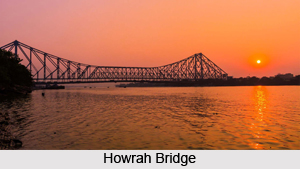 Monuments in Kolkata constitute a majority of the Mughal as well as the British architecture. The city owes much of its existence to the British Raj. The well-known monuments in the city of Kolkata are structures belonging to that period. Kolkata city was founded by the British and has a short history of about four hundred years. There are very less old monuments of pre-British period. However the British erected quite a few buildings for the purpose of development. A number of the monuments are associated with the Indian freedom struggle giving them a monumental stature. The prominent among them are the Howrah Bridge, Raj Bhawan, Victoria Memorial, Saheed Minar, BBD Bagh and Writers` Building. Kolkata was founded on insalubrious mud flats beside the Hooghly River by the English merchant Job Charnock in the year 1690. From this initial toe-hold, the settlement developed to form the capital of British India and, after London, the second city of the Empire.
Monuments in Kolkata constitute a majority of the Mughal as well as the British architecture. The city owes much of its existence to the British Raj. The well-known monuments in the city of Kolkata are structures belonging to that period. Kolkata city was founded by the British and has a short history of about four hundred years. There are very less old monuments of pre-British period. However the British erected quite a few buildings for the purpose of development. A number of the monuments are associated with the Indian freedom struggle giving them a monumental stature. The prominent among them are the Howrah Bridge, Raj Bhawan, Victoria Memorial, Saheed Minar, BBD Bagh and Writers` Building. Kolkata was founded on insalubrious mud flats beside the Hooghly River by the English merchant Job Charnock in the year 1690. From this initial toe-hold, the settlement developed to form the capital of British India and, after London, the second city of the Empire.
In its heyday, the city of Kolkata was known as the city of palaces, and it still retains a fine heritage of the eighteenth century and the nineteenth century buildings, often in a bad state of repair. By the later parts of the nineteenth century, darker associations of urban squalor began to predominate, popularized in Kipling`s City of Dreadful Night. However, although Kolkata has become a byword for social deprivation and overcrowding, it is at times a pleasant surprise for the visitor to discover the charming legacy of architecture of the colonial period which survives to give the city its distinctly British mould.
The original settlement was centred on the Old Fort William, which is situated in the northern parts of the present site, roughly in between the present General Post Office Building and the river. After the sack of Kolkata and the infamous incident of the Black Hole tragedy in the year 1756, when Robert Clive recaptured the city, a new fort was constructed at enormous cost. The whole area around the fortifications was cleared to create an open field of fire, and this vast open space known as the Maidan, became the focus for the subsequent development of the city.
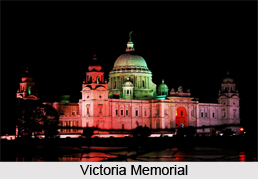 Most of the major monuments and historic buildings are to be found in the northern section of the city of Kolkata, between the Eden Gardens and the Howrah Bridge and these can be visited easily on foot at a leisurely pace. The direction may vary at will but begins at the junction of Council House Street and Hastings Street at St John`s Church. Designed on the pattern of St Martin-in-the-Fields, London, St John`s was formerly the cathedral church. It was designed by Lieutenant James Agg. The Churchyard is well worth close inspection as there are numerous fine historical monuments here. Especially noteworthy is the Rohilla Monument, a domed cenotaph based on Sir William Chambers`s Temple of Aeolus at Kew. It has twelve Doric columns having a frieze enriched with triglyphs, shields and buerania (rams` skulls). It memorializes the dead of the Rohilla War of the year 1794.
Most of the major monuments and historic buildings are to be found in the northern section of the city of Kolkata, between the Eden Gardens and the Howrah Bridge and these can be visited easily on foot at a leisurely pace. The direction may vary at will but begins at the junction of Council House Street and Hastings Street at St John`s Church. Designed on the pattern of St Martin-in-the-Fields, London, St John`s was formerly the cathedral church. It was designed by Lieutenant James Agg. The Churchyard is well worth close inspection as there are numerous fine historical monuments here. Especially noteworthy is the Rohilla Monument, a domed cenotaph based on Sir William Chambers`s Temple of Aeolus at Kew. It has twelve Doric columns having a frieze enriched with triglyphs, shields and buerania (rams` skulls). It memorializes the dead of the Rohilla War of the year 1794.
Other historical monuments in the Kolkata city in West Bengal include the Tomb of Job Charnock, which is considered to be one of the earliest surviving British monuments in India, surrounded by thirty or more early tombstones. The tomb was made of gneiss from Pallavaram near Chennai, designed with horizontal ribs. Inside are four raised tombstones. One is devoted to Surgeon William Hamilton, who cured the Mughal emperor Farrukhsiyar of venereal disease and as a result won extensive trading rights for the East India Company in Bengal. Close to it is the Admiral Watson`s Tomb, crowned by a large obelisk, which was relocated within the churchyard in the year 1983. There is a monument to his memory in Westminster Abbey. A white domed classical pavilion covers the Tomb of Begum Johnson, matriarch of Kolkata society. In the western corner lies a marble monument to the Black Hole of Kolkata which originally stood at the western end of Writers` Building in Dalhousie Square. It replaced an earlier structure constructed in the year 1782, but was removed here on independence. The Grave of Lord Brabourne is also located nearby.
At the junction of Hare Street and Strand Road stands Metcalfe Hall, now partially obscured by a high wall. A short towards the south to Esplanade Row West leads to the High Court, by Walter Granville. It is the most important Gothic building in the city. To the east of the High Court is located the Town Hall, by Colonel John Garstin. Beyond is Government House, the residence of the British Governor Generals and Viceroys until the year 1911, now renamed Raj Bhavan and the official residence of the Governor of Bengal. Dalhousie Square is situated in the heart of the area once covered by the original Fort William before the new fort was built to the south between the year 1757 and 1770. The entire north side of the square is occupied by Writers` Building. This enormous edifice was refaced in the year 1880 with terracotta dressings, reflecting Victorian Imperial and civic pride, but the refacing conceals a much earlier structure, constructed by Thomas Lyon in the year 1780, as the mercantile headquarters of the British East India Company, where the Company`s writers were based. To the west of Dalhousie square is the General Post Office. This monumental building stands on the actual site of the Black Hole.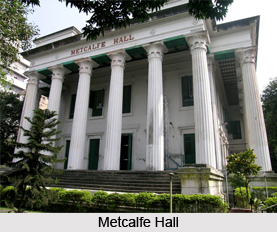
Netaji Subhas Road in the north-west corner of the square leads north, past the East Indian Railway Offices, a colossal Italianate structure covering an entire street block, designed by R. Roskell Bayne. Close to it is the Royal Exchange which was designed by T. S. Gregson, an eloquent composition resembling a London bank, with paired Corinthian columns in antis and a crisply detailed attic storey. In Armenian Street, situated in close proximity to the Howrah Bridge, is the oldest church in Kolkata. The Armenian Church of Holy Nazareth has a tombstone from 1630 in the churchyard. The Church was designed by an Armenian from Persia, known as Cavond. In the year 1790, Catchich Arra-kiel constructed the adjoining clergy house and added a clock to the steeple. A little to the east is the Roman Catholic Cathedral, the Portuguese Church of our Lady of the Rosary. The Howrah Bridge, a civic landmark, is the only connection across the Hooghly River. The design of the bridge was made by Hubert Shirley-Smith and the structure was erected in the year 1943 to replace an earlier pontoon bridge constructed by Sir Bradford Leslie in the year 1874. The vast, single, cantilever span is over 457 meters in length and it dwarfs the entire area. The bridge leads to the Howrah Railway Station.
Among the notable monuments in Kolkata, Fort William is a prominent one. It is one of the most impressive examples of European fortification in the East. Roughly octagonal in shape, with six principal gates, it was designed by Captain John Brohier in the year 1757 and took thirteen years to be completed at a staggering cost of over two million pounds. It replaced old Fort William, which lay slightly to the north. The Fort is occupied by the army. Access is restricted but it can be arranged by appointment. St Peter`s Church forms a picturesque centrepiece to the Fort. It is now a library. The Outram Institute, formerly the Fort House, is notable as one of the former residences of the Governor-General prior to the erection of Government House in the year 1803, after which it was used by state guests and the commanding officer. Outside the Fort on the river frontage is Prinsep`s Ghat, an Ionic pavilion erected to commemorate James Prinsep, the antiquarian and Orientalist. Mosque of Tipu Sultan is the third in the series, built by his son Muhammad. It is based on a slightly earlier prototype, the mosque of Ghulam Muhammad in the suburb of Tollygunge.
Chowringhee Road, running southward from the Dalhousie square, forms the eastern boundary of the Maidan. The elegant interior of the Grand Hotel, one of the most fashionable in the city of Kolkata, facing the Ochterlony Monument, is hidden behind an understated classical facade. At the rear, in Surendranath Banerjee Road, are the Municipal Offices, which were designed by W. Banks Gwyther. Behind the Grand Hotel, in Lindsay Street, the Hogg Market was located, which was named after Sir Stuart Hogg. In the Wellesley Street, there is the Calcutta Madrasa, a Muslim college founded in the year 1780, by Warren Hastings and, in Wellesley Square, the Scottish Church.
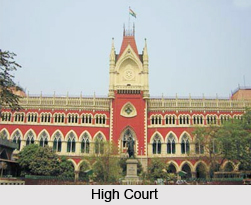 The Indian Museum is situated in the Chowringhee Road, opposite to the Monohar Das Tank, which was excavated in the year 1793. The Museum, on the corner of Sudder Street, is one of the best in India, with an enormous collection of geological, archaeological and zoological artefacts. At the Park Street corner is the Royal Asiatic Society of Bengal, in a partially demolished building. Founded by Sir William Jones, linguist, judge, classicist and polymath, in the month of January 1784, it was the forerunner of a series of learned societies which became a notable feature of the British presence in Asia. The Convent of Our Lady of Loretto was previously the home of Henry Vansittart, Governor of Bengal, and also of Sir Elijah Impey, first Chief Justice of the Supreme Court. St Thomas`s Roman Catholic Church is situated close to it. The Royal Calcutta Turf Club was previously the home of the Apear family, shipping magnates. Such houses display the first stage in the adaptation of European classical styles to an Indian context, with pedimented verandas and exaggerated intercolumniation.
The Indian Museum is situated in the Chowringhee Road, opposite to the Monohar Das Tank, which was excavated in the year 1793. The Museum, on the corner of Sudder Street, is one of the best in India, with an enormous collection of geological, archaeological and zoological artefacts. At the Park Street corner is the Royal Asiatic Society of Bengal, in a partially demolished building. Founded by Sir William Jones, linguist, judge, classicist and polymath, in the month of January 1784, it was the forerunner of a series of learned societies which became a notable feature of the British presence in Asia. The Convent of Our Lady of Loretto was previously the home of Henry Vansittart, Governor of Bengal, and also of Sir Elijah Impey, first Chief Justice of the Supreme Court. St Thomas`s Roman Catholic Church is situated close to it. The Royal Calcutta Turf Club was previously the home of the Apear family, shipping magnates. Such houses display the first stage in the adaptation of European classical styles to an Indian context, with pedimented verandas and exaggerated intercolumniation.
The east end of Park Street possesses the Cemetery, an essential part of any itinerary. For a true understanding of life in the days of the East India Company, the surviving Georgian houses in Chowringhee and closely-located Park Street Cemetery are a must. Recently restored under the aegis of the British Association for Cemeteries in South Asia, Park Street resembles an Imperial city of the dead. Pyramids, pavilions, catafalques and obelisks, some of colossal scale, lie thickly concentrated behind the perimeter walls in one of the finest repositories of neo-classical funerary sculpture outside Europe. Noteworthy tombs comprise of the huge pyramid Tomb of Elizabeth Barwell, the neo-classical Pavilion to Major-General John Garstin, architect of the Town Hall, Kolkata, and the Gola, Patna, and the famous spiral Monument to Rose Aylmer, carrying a later inscription by the poet Walter Savage Landor.
A little to the north is Lower Circular Road Cemetery, opened in the year 1840, which contains a number of interesting graves. Close to the Gothic style entrance range lays Sir William Hay Mac-naughten, the British envoy to Kabul, who was killed there on the 23rd of December 1841. The nearby grave to it is that of Sir William Casement. In the south of the Lower Circular Road is Bishop Middleton`s College consists of a chapel, planned as a small basilica, the principal`s and professors` house, lecture rooms and library. Opposite of it is the La Martiniere Schools. The girls` school was designed around a remodelled 18th century house with an elephant porch. The boys` school was built to the designs of R. H. Rattray and Captain Hutchinson, a military engineer, in the year 1835, and built by J. P. Parker. Ionic porticos on the north and south facades offer access to a central chapel.
St Paul`s Cathedral is one of the notable monuments in Kolkata situated in the south-eastern corner of the Maidan, in close proximity to the Chowringhee Road, and is visible from some way off, soaring high above the trees. An earthquake destroyed the original steeple in the year 1897. It was reinstated, but after another earthquake in the year 1934, the main tower was recast to the design of Bell Harry Tower at Canterbury. In the western direction of the Cathedral is situated the most potent symbol of British supremacy in India, the Victoria Memorial, by Sir William Emerson, president of the Royal Institute of British Architects. Soaring high over the southern end of the Maidan, the Memorial dominates the centre of the city.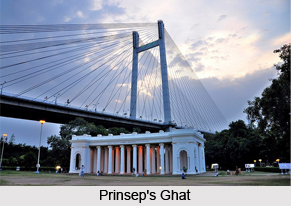
The Eden Gardens is situated to the east of Strand Road, in between the Babu`s Ghat and Chandpal Ghat, bequeathed by Emily and Fanny Eden, daughters of Lord Auckland. Part of the area is covered by the Kolkata Stadium, home of Test cricket. In the garden area is a small lake, beside which lies the Burmese Pagoda, seized during the First Burmese War, dismantled and re-erected in the year 1854, as an exotic war memorial. Eden Gardens Road curves northward to the direction of Government House compound, where one can have the glimpse of the south front between the mature perimeter foliage. To the east is situated the Ochterlony Monument or the Sahid Minar, designed by C. K. Robison and completed by J. P. Parker. The monument, remembers the General Sir David Ochterlony, victor of the Nepal War, is an extraordinary fluted Greek Doric column, 152 ft. in height, standing on an Egyptian-style plinth and crowned by a metal cupola of Turkish origin. On the top are two narrow viewing platforms from which spectacular views of the city can be obtained. Access is not usually possible. Curzon Gardens, immediately to the north, were laid out by Lord Curzon on the plan of the Union Jack.
The southern suburb of Tollygunge possesses the renowned Royal Calcutta Golf Club, another well-maintained late eighteenth century house in a beautiful surrounding. Here also is the Mosque of Ghulam Muhammad, a double-aisled rectangular mosque with an unusually inventive commingling of European and Islamic architecture. Closely-located is the second in the series, the Mosque of Shahbani Begum, another double-aisled, multi-domed structure, unusual in Bengal, where a tradition of single-aisled mosques developed. Since the city of Kolkata was under the influence of the Mughals as well as the British, the art and architecture of the historical monuments of the city are also being suitably influenced by the rulers. Several old historical monuments, still standing tall in Kolkata city of the state of West Bengal, exhibit a fine blend of the indigenous, British and Mughal architecture.




